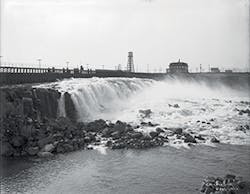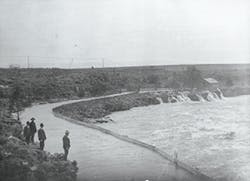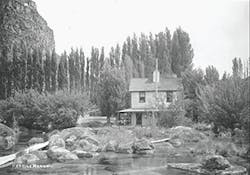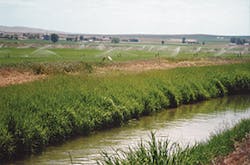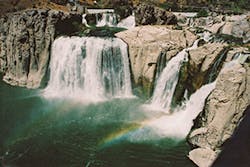Visitors to Twin Falls, ID, during the summer months find it much cooler than the original pioneers of the 1800s would have. Streams and ditches meander through the town, which is lined with yellow irises and cattails. They cool the air and provide trees and shade to take breaks from otherwise sweltering summer days. Some measure several feet both across and deep, while others are barely noticeable. But what visitors to the Magic Valley don’t know is that most of them are part of a manmade irrigation system constructed in the 1900s, financed by a team of private investors.
Retired Twin Falls police officer, Bill “Stoney” Stonemets has used the ditch irrigation to water his home’s corner lot for many years. The double lot in city limits boasts evergreens, shrubs, trees, a sprawling green lawn, and his prize vegetable garden. He has only recently installed sprinklers to his property so he can “have a break” during the summer. Typically, because they run through many properties, shareholders of domestic ditches determine how ditch water is taken from the ditches, what days it’s used, how it’s divided up, and who will do maintenance. They remove the water by way of hoses, pumps, diversions, and small dams in the ditch made of sheet metal or wood. One of the things Stonemets has noted through the years is that he’ll see a property that has ditch water available, but the owner decides to take it out of use for some reason.
Power canal
There are a couple of ways that landowners can take the ditch out, he explains. First, they can let the water run and not use it. While this may seem like a waste of water to some, it actually irrigates the lots that it runs along. And it provides water that seeps down into the soil. The water that is allowed to run down the ditch will simply flow through the system to be used by the next user down the line. Another way to take a ditch out is to have a concrete pipe put in so that the water still moves through the ditch, but just doesn’t flood their area. One of the problems, he says, is that all the volunteer trees go with the water—they all die. And as a last resort, people will sometimes cave in the ditch, and in that case, it creates a mess, he says.
In addition to the trees that may die, he describes how taking ditches out creates other problems in town. “Those ditches are also drains. They act as a drainage system in town. So, if a guy says he doesn’t want to mess with the ditches, I say, where will the water flood to when we get a lot of snow melt or rain?”
When the ditch has a culvert installed that covers the ditch, but has an entrance and exit for the water, it may not be so bad because stormwater has a place to enter and exit the drainage system. Twin Falls is not yet required to have an official stormwater pollution prevention plan (SWPPP) in place. But if the ditch is closed up completely with dirt or concrete, which is against the Twin Falls Canal Co. (TFCC) regulations as well as being an Idaho misdemeanor, then the water has no place to run and ends up causing flood problems, Stoney notes.
“When the ditch system was run back a long time ago, back in the old days, it was done that way for a reason. And we had to maintain those ditches. Now, it seems like nobody cares.”
Of course, since the original irrigation system was put in place, Twin Falls has grown tremendously. More growth means more people. And one reason that landowners in town would decide to take a ditch out of use is to protect themselves against liability. If the ditch is much deeper than a few inches, which many are, the problem becomes the neighborhood children. The kids who are out of school during the hot summer months seem to think the ditches are their own private swimming holes, and in spite of the educational efforts by the TFCC, there are accidents.
Perrine’s home in Idaho
For landowners who choose to keep their water rights active, the TFCC supplies educational materials in the way of newsletters detailing current legal issues, and how-to information. They provide specifics of the canal company’s assets and debts and net value, along with who to contact for various issues that may arise. If someone with a water share wants to use their ditch water, they must maintain the ditches and head gates. On the other hand, if they choose to not use it, there are remedies other than closing up a canal, as well. For the TFCC water shareholders who choose, for some reason, that they no longer want to use that water, they can lease, or even sell their shares. It’s easiest to think of the water in terms like thinking of money at the bank. Often the use of it is on paper, but used at a later time after being “banked.” The actual water right stays with the land, but as long as sale or lease of that water would not injure another shareholder, and it remains in the same district, it can be used by another.
The TFCC, in all its simplicity, is actually very politically interdependent.
Back to the Beginning
The TFCC is much more than a system of meandering streams running through a small desert town. It is the largest Desert Reclamation project in United States history and the third largest in the world. The Milner Dam, where it all begins, boasts over 100 miles of drain canals and over 1,000 “feeder” canals. And during a time when pressure was being put on Washington to “tame the West,” the system was put in using private investor money—without the use of government money.
Brian Olmstead, general manager of TFCC, describes it with pride. “It was an amazing accomplishment. The engineering was incredible. It’s a beautiful canal system and it functioned. And it still functions the same way today.”
The irrigation system was the dream of one of the oldest settlers to the Magic Valley area—Ira Burton Perrine. He came to Idaho in 1884 from Indiana and began farming in the Snake River canyon downstream from the 212-foot high Shoshone Falls. Being an accomplished businessman, he continued to pursue his dream of irrigating the desert land at the top of the Snake River canyon. The area is now known as the Magic Valley. His vision was to irrigate 500,000 acres to help farms thrive in an otherwise arid desert. The 1894 Carey Land Act had taken hold and made reclamation, and thus Perrine’s vision, a reality; in 1900, he incorporated the Twin Falls Land and Water Company. The first thing he did was contract with the state of Idaho to develop 270,000 acres, using water diverted from the Snake River.
Selling a Dream to Pioneers
It must have been an amazing challenge to sell investors on the idea that the desert in Southern Idaho could thrive. The 300 square miles was a dry, parched desert along the Oregon Trail. Sagebrush dominated the landscape, much like it does today. Settlers arriving during the summer months between June and September would have been terribly disappointed. Annual precipitation for Twin Falls is 10.2 inches, with only a 19% average chance that it will rain sometime during any given day. The cold, semi-arid steppe climate may have provided some snow during the cooler season between November and February, at which time they may have had a 57% chance of light snow on any day and maybe a 22% chance of light rain. But for the pioneers, there would have been little chance of capturing enough of this precipitation to sustain crops.
To put this in perspective, settlers brought seeds and potatoes to begin their farms with them—wherever they settled. They brought their cattle, horses, pigs, and as much feed as they could manage. They would have relied on the landscape for grazing their animals, only supplementing their diets with small amounts of grain. Imagine how disheartened they would have been when witnessing only sagebrush and small pools of water, some 300 feet down in the canyon.
Farm crops without irrigation
Farm Crops Without Irrigation
For the planting and harvesting of their crops, settlers would have found the Idaho desert even bleaker. In Twin Falls, when beans are setting their pods and needing water—around the middle of July—they would have depended solely on that 19% chance of receiving rain. Mid-July is when the air is the driest, and at the same time, the relative humidity drops below 26% three out of four days. And rather than a nice breeze taking some of the heat off, the wind speed drops to below 9 miles per hour, making the air hot and stagnant. Although the dry air in August would have helped the beans dry, those August winds were known to get up to 15 miles per hour, landing one guy’s beans over in another guy’s field. When they were planting potatoes, they would have battled winds up to 20 miles per hour in early April. Rather than having big machines doing the planting, the settlers would hand plant from baskets or boxes behind a horse drawn plow. It seems without the aid of irrigation, and a lot of friendships, there would simply be no Magic Valley.
Milner Dam and Shoshone Falls
Irrigation in the West dates as far back as the Hohokam Indians, who developed an extensive canal system on the Salt River in Arizona. But looking down the steep canyons of the Snake River, the notion of irrigation must have seemed a daunting task to pioneers in the scorched Idaho desert. Surveying the thirsty desert with little more than sagebrush and rattlesnakes, some might have been seen simply shaking their heads in dismay at the idea.
The concept that a 73-foot dam could be constructed across 2,160 feet of the Snake River canyon—using horse drawn wagons and manpower alone—would have literally seemed a daydream to some. But Perrine had already trekked up and down the river scouting out an area for a railroad bridge when he realized the site was perfect for a dam. There he realized he had his dam for irrigation. The site later became the Milner Dam, named for investor Stanley Milner, a Salt Lake City banker. Perrine knew that, in all its simplicity, his plan would work. After all, there was no shortage of gravity.
And gravity is what the entire canal system runs on. It is all quite simple actually. TFCC records list it as simple as “build a dam across the Snake River and send the water into two main canals. Then build smaller canals, called laterals, to reach the farms. Install a head gate at each farm to measure the water shares and run small ditches down the fields in furrows to irrigate beans and alfalfa.”
Olmstead says that the system was so simple, yet efficient, that they would make few changes if building it today. “If we were going to build the canal system today, it might be done a little bit differently, and we could do it maybe faster. But it wouldn’t be any better.”
The Carey Land Act, signed August 18, 1894, provided for the transfer to western states of the US-owned desert lands, but with the stipulation that the land must be irrigated. At an unheard of price for land on today’s market, settlers were allowed to purchase up to 160 acres at 50 cents per acre. They had to also pay the costs of water rights, $25 an acre, and the costs of bringing the water to their land to irrigate. Unfortunately, without financial backing, most of the reclamation and settlements were a disappointment due to the costs of irrigating the vast deserts of the Western states.
The Magic Valley had special interests and investors willing to take a calculated risk on Perrine’s irrigation dream. Idaho has, today, some very successful examples of the four stages of Reclamation in operation. The US Reclamation Service, now the Bureau of Reclamation, was instrumental in these maneuvers. These shining successes in Idaho include individual farmers or land owners, with their own ditches and water diversions; private canal companies, primarily located in the upper Snake River Valley; Carey Act projects that are still found mainly around Twin Falls; and Reclamation projects, the largest in Boise and Minidoka. Many century-old ditches remain in use for Idaho farmers today. It’s estimated that 60% of all Carey Act lands irrigated in the United States, are located in Idaho, according to TFCC literature.
After Perrine secured the financial backing from Milner, as well as eastern investors Frank Buhl and Peter Kimberly, the construction began moving forward. The Buhl-Kimberly Corp. built the dam and established the TFCC in 1903–1905. By 1905, Perrine had already spoken for any water south of the Milner Dam in the Snake River that could be appropriated by the state.
“On March 2, 1905, the gates of Milner Dam were closed and the gates to over a thousand miles of irrigation canals and laterals were opened, and the Snake River was diverted,” explains Joe Yost, dam tender with the TFCC. “The water rushed across the desert far above, and Perrine’s vision was realized, and 260,000 acres of desert was shortly transformed.”
That night, some 30 miles downstream from Milner, the Shoshone Falls slowly came to a silent trickle. After rumbling and tumbling for 14,000 years, the waterfall nicknamed “Niagara of the West” fell silent for the first time. It must have been an eerie silence to those standing above on the canyon rim.
Irrigation on the south side was sent down first. Canals measuring 10 feet deep, and 80 feet wide at the bottoms and 120 feet at the top, were filled to send the water to Twin Falls area farmers. The north side, now Jerome County, was later flooded in canals that irrigated 185,000 acres on what’s known as the North Side Tract. The Magic Valley came to life in full bloom. Farmers harvested approximately 30,000 acres of crops in that first year alone.
“The economy of the Magic Valley and all the small towns in the Magic Valley are totally dependent upon the agriculture that the water produces here,” says Olmstead. “If we didn’t have the canals and the water delivery, there wouldn’t be the towns of Twin Falls, Kimberly, Filer, Buhl, or Hansen. It’s what built the economy here and what sustains it. And I hope it continues to do that in the future, too.”
Shoshone Falls at a high-flow time
Of course, in any area where there are farms and a thriving economy, there are also other things that allure people to the area. Schools, churches, savings and loans, libraries, healthcare, and general stores were all believed to go along with a civilized society, and because of Perrine’s dream, today over 250,000 residents call Magic Valley home. In addition to the Milner Dam, the other “guardian” of the waters—TFCC—is what has made it all possible.
In addition to the Twin Falls project, there was the first federal water project under the National Reclamation Act of 1902 that established the Minidoka Dam that watered 120,000 acres on the north and south sides of the Snake River. After its completion in 1907, the Minidoka Dam supplied water that helped develop the smaller communities around the Magic Valley.
It’s a Sacred Trust Issue
From the very beginning, the TFCC has been owned and operated by its approximately 5,000 water shareholders. Foremost irrigation users sit on the board of directors and are held accountable to the community. They understand irrigation and the decisions that must be made in the use of water and how it is supposed to be managed. Olmstead’s own great grandfather took their family farm out of sagebrush back in 1905, when these dams were being constructed. He has a keen understanding of Idaho’s water issues, and is committed to the shareholders of TFCC.
“The Twin Falls Canal Company has a sacred trust with all our stockholders,” he says emphatically. “That we will take care of and maintain this company so we can always deliver water to the farmers.”
In 1905, when those first canals were filled, it attracted homesteaders and farmers because there was so much water to use and barely any people to use it. That was back then. Today, the challenge has tipped in the opposite direction.
On the north side of the Snake River, rather large springs, almost considered “point source” springs, feed the river. But on the south side, “seep” springs that feed into the aquifer are smaller and sparser. During the irrigation season, about half of the canal water comes from the larger springs that feed the river. TFCC historian and archivist Joe Webster describes how prior to the Milner Dam and irrigation of the south side of the river, on the Twin Falls Tract, the desert was just the desert. When the snow melted, the ground got some water, and when it dried up, it was gone. The springs were there, but only ran when they were recharged by natural precipitation in the area. Once there was irrigation and a continual supply of water, the ground would not let it drain faster than the water was being applied. So it elevated the water level. At certain times of the year, when more water is available, like again during snow melt and runoff, the springs run faster because they are being recharged faster than the water is being used, or faster than it’s evaporating. In those older days, this caused a seepage problem in some areas, and they installed drains that allowed the water the drain off. These drains are still in place in some areas.
In the last four decades, however, TFCC notes that the springs have steadily decreased. Sometimes described as similar to Lake Erie in size, the overall Eastern Snake Plain Aquifer is one of the largest and most productive aquifers in the world and has very unique characteristics with regard to groundwater recharge. This recharge is “predominantly from infiltration of applied irrigation water, infiltration of stream flow, and groundwater inflow from adjoining mountain drainage basins. Some recharge may be from direct infiltration of precipitation, however the hot, arid climate of the Plain make this a minimal contribution.” (See the digital geology of Idaho here.)
Olmstead notes that in these past four decades, due to increased water demand from a growing population, and the change from flood irrigation over to sprinklers, there has been an overall decrease in water returned to the aquifer. Additionally, there have been in the range of “thousands” of irrigation wells drilled into the aquifer above the springs. Olmstead says these wells suck up the spring water that the TFCC tract farmers depend on for their crops—and thus, their livelihoods.
“The Twin Falls Canal Company has a 1900 Water Right for 3,000 cfs [cubic feet per second] for water from the Snake River,” he explains. “And that is what we count on and need to deliver the water to our farmers.”
TFCC attorney, John Rosholt, explains the decline. “We coasted along for, basically, 70 years, with the 1900 Water Right and enough flow to get by—with little supplement toward water storage every year. Suddenly, this pumping starts to show up in the spring flows. And they start to decline and it gets to the point that people like the TFCC, are having to lease additional water to get through a season that they were always able to manage with very little storage and their natural flow rights.”
Since water usage in Idaho falls under the “first in time, first in right” principle of Western water law’s Prior Appropriation Doctrine, and the TFCC holds the senior Water Right, they could theoretically force shut down of the irrigation wells if they take the allotted water, and it proves to be injurious to shareholders. But, Olmstead says, what can be done in theory is politically not always easy to do, realistically.
Rosholt adds that “the groundwater people are the guys that came last and spent a lot of money to develop their facilities—their infrastructure—and they put a lot of acres on the tax roles. And, politicians like acres on the tax roles.”
In addition to the political aspects, in 1994 the director of the Idaho Department of Water Resources affirmed Rules for Conjunctive Management of Surface and Ground Water Resources (Idaho Administrative Code 37.03.11.001-.999). These rules give the director specific guidance in dealing with a delivery call “made by the holder of a senior-priority surface or groundwater right against the holder of junior-priority groundwater right in an area having a common groundwater supply.” It all goes back to the traditional policy of “reasonable use” and whether a senior-priority user has actually suffered quantifiable injury at the hands of a junior-priority groundwater user. The Conjunctive Management provides specific factors to be considered in these cases.
“We are all farmers and we like our farmers,” adds Olmstead. “And we don’t like to see hardship on them. But it’s our obligation to defend that Water Right we’ve had since 1900. To the extent to which those groundwater pumpers affect those spring flows, we have to fight for that water—every last drop of it!”
Other TFCC Endeavors
In addition to being the overseer of the water, TFCC works aggressively with farmers in the Magic Valley to preserve topsoil. The agricultural community has worked hard to develop a system of catch ponds to settle out the sediment before it goes to the Snake River. Since 1905, when the first canal was filled, irrigation water has been carrying topsoil away from the farms, and with a shallow soil layer to begin with, farmers know how critical this is.
“We all know that not only do we not want it in the River, but we have to work to keep it on the farms,” emphasizes Olmstead.
From the main Perrine Coulee, canal water runs through a series of ponds planted with “bull rush” and other water plants that help filter out topsoil and create waterfowl habitat at several locations. It is estimated that some 1,000 tons of fertile topsoil is recovered in the ponds each irrigation season.
The preservation of topsoil isn’t the only thing provided to Magic Valley through the efforts of the Canal Company. From the first construction days of the Milner Dam, hydropower plants have been built along the Snake River. It’s said that “in Snake River country, where there’s water running downhill, there’s probably someone trying to produce electricity with it.”
The TFCC hydropower plant generates enough power for over 7,000 homes and provides money for canal system improvements. In 1988, when the Milner Dam was assessed for earthquake stability, the high risk of it failing was determined to have an $11 million price tag to bring it up to standards. Rather than shareholders shouldering the costs, the Twin Falls and North Side Canal companies entered into an agreement with Idaho Power Co. The mutually beneficial agreement provided for rehabilitation of the dam, along with construction of a 57.5-MW power plant, downstream from the dam. The other side of the agreement from Idaho Power was that their repayment of the loans would come in the form of “royalties” from the hydropower plant.
“It’s good green, renewable energy,” says Olmstead, referring to the Midway and South Fork hydropower plants. “It doesn’t rob energy from any other source and it makes money for our shareholders. It’s a good situation and one that we’re proud of.
“We’re not the same company we were a hundred years ago. Back then, we had to go out with a hose and a shovel and deliver water to the farmer. We still do deliver water to the farmers, but in addition to that, we have to be environmental engineers, [we] have to be politicians, we have to be lawyers. We have to do a lot of different things to defend the water rights and continue to deliver the water to the farmers as we always did. And we feel that’s a sacred trust and we’ve done it for the last 110 years. Now we plan on doing it for the next 100 years and into the future.”
